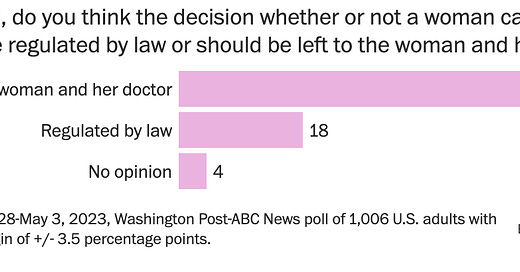It is acceptable for people to have different points of view on abortion and abortion rights and to advocate for them. But it is not acceptable to lie. Here are some common abortion related lies:
Lie #1. The United States is deeply divided on the abortion issue.
In fact, polling shows that Americans now strongly believe that the decision to have an abortion should be personal and not regulated by law. The results of a recent poll (28Apr23 to 3May23) were:
In fact, most Americans in most states believe abortion should be legal, even in Alabama, Florida, Texas and Wyoming.
Source: Washington Post, 23 February 2023
Lie #2. A “fetal heartbeat” at 6 weeks is comparable to an adult heartbeat.
Some states have passed laws to make abortion illegal as soon as an embryo has detectable cardiac activity (i.e. a “fetal heartbeat”), which could be as early as 6 weeks. However, this “fetal heartbeat” is not equivalent to an adult heartbeat:
"When I use a stethoscope to listen to an [adult] patient's heart, the sound that I'm hearing is caused by the opening and closing of the cardiac valves," says Dr. Nisha Verma, an OB-GYN who specializes in abortion care and works at the American College of Obstetricians and Gynecologists.
The sound generated by an ultrasound in very early pregnancy is quite different, she says.
"At six weeks of gestation, those valves don't exist," she explains. "The flickering that we're seeing on the ultrasound that early in the development of the pregnancy is actually electrical activity, and the sound that you 'hear' is actually manufactured by the ultrasound machine."
That's why "the term 'fetal heartbeat' is pretty misleading," says Dr. Jennifer Kerns, an OB-GYN and associate professor at the University of California, San Francisco.
Source: NPR.org
A recognizable four chamber heart is not present until week 9, and even then, a beating heart is not the only factor that determines legal status, moral status and personhood.
Lie #3. Early embryos have visibly identifiable body parts.
Abortion tissue, up to 9 weeks, is typically not discernible to the human eye and has no identifiable body parts. The images shown below demonstrate that this tissue does not look like what people expect and that many of the images widely circulated by the anti-abortion rights movement do not represent early pregnancies.
The progression from 5 to 6, 7, 8 and 9 weeks of pregnancy. Photograph: MYA Network. Note size of specimens in centimeters or inches.
Pregnancy tissue at 9 weeks. Source: New York Times.
“When we examine the tissue after a procedure, everyone is consistently surprised. They expect to see an embryo, fetus or at least some body parts,” he told us, describing the students’ experience as “underwhelmed.”
But our primary daily work, of course, is with patients. And when our patients look at the tissue, it often makes them realize how much guilt or even shame they have internalized from society’s judgment in making this deeply personal decision. New York Times
Lie #4. Anti-abortion laws have meaningful exceptions.
The response to antiabortion laws is often that there are exceptions to allow abortions in the most sympathetic cases. However, in practice, these exceptions are rarely used:
But in the months since the court’s decision, very few exceptions to these new abortion bans have been granted, a New York Times review of available state data and interviews with dozens of physicians, advocates and lawmakers revealed.
Instead, those with means are traveling to states where abortion is still broadly legal or are obtaining abortion pills at home because the requirements to qualify for exceptions are too steep. Doctors and hospitals are turning away patients, saying that ambiguous laws and the threat of criminal penalties make them unwilling to test the rules.
“Having the legal right on the books to get an abortion and getting one in practice are two distinctly different things,” said Laurie Bertram Roberts, the executive director of the Mississippi Reproductive Freedom Fund, a group that supports abortion rights.
Even with exceptions allowed by law, it is often unclear at what point an abortion is allowed. Yet physicians with patients in crisis cannot wait to consult with lawyers, an ethics board or a judge. To avoid being charged with a felony, many physicians will delay or deny appropriate care even though they know they are endangering their patients’ lives.
Many of these laws are unclear even to hospital administrators. A recent study concluded:
Not a single hospital in Oklahoma appeared to be able to articulate clear, consistent policies for emergency obstetric care that supported their clinicians’ ability to make decisions based solely on their clinical judgment and pregnant patients’ stated preferences and needs.
In practice, the exceptions are meaningless. This is not surprising since these laws and policies, including the Dobbs decision, were passed with minimal input and despite fierce opposition from the medical community.
Index to Nat’s Substack articles
If you like these essays, please share them with others.
Follow me on Substack or LinkedIn or through our Curing Cancer Newsletter .
Follow our Curing Cancer Network on LinkedIn and Twitter. Twice a week we post interesting cancer related images of malignancies with diagnoses.
Latest versions of our cancer related documents:
American Code Against Cancer (how you can prevent cancer)
Email me at Nat@PathologyOutlines.com - unfortunately, I cannot provide medical advice.
I also publish Notes at https://substack.com/note. Subscribers will automatically see my notes.







